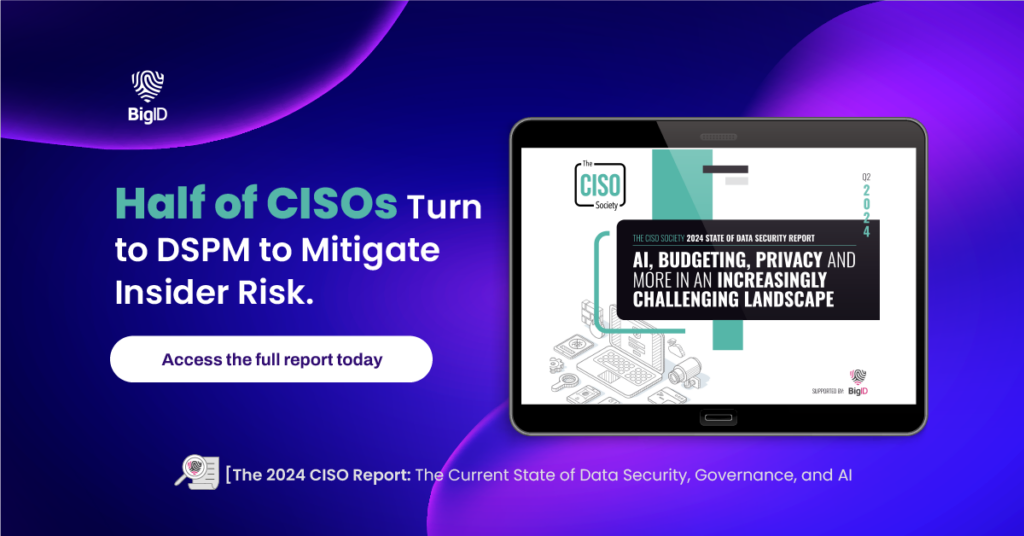The National Institute of Standards and Technology (NIST) has recently revamped the Cybersecurity Framework (CSF) for the first time since 2014, responding to Executive Order (EO) 13636, which was designed to improve capabilities for critical infrastructure to manage cybersecurity risk.
In February 2024, NIST released version 2.0, which includes several changes to address growing cybersecurity challenges and provides a methodic approach to assessing and strengthening cybersecurity posture. The most significant difference between NIST CSF 1.0 and NIST CSF 2.0 is the update to the Framework Core function, which previously had only five functions but is now six, including the “Govern” function.
The 6 Core Components of NIST with BigID
The NIST CSF framework’s core is focused on six essential functions: Govern, Identify, Protect, Detect, Respond, and Recover. These functions provide a streamlined approach to the cybersecurity risk management lifecycle. BigID can help organizations align with the core functions and comply with the requirements of NIST CSF 2.0.
1. NIST CSF Govern Function
Govern (GV): This function enables organizations to prioritize, communicate, and monitor their cybersecurity risk management strategy, policies, and processes to strengthen strategic planning and secure data.
Govern with BigID
To address this core function, BigID helps enforce and manage hundreds of out-of-the-box policies to monitor and protect data by type, sensitivity, regulation, residency, location, and more. BigID aligns with the NIST CSF framework to improve data risk management, privacy posture, and security programs in a unified platform.
2 . NIST CSF Identify Function
Identify (ID): The identify function focuses on an organization’s comprehension of current cybersecurity risks. It requires organizations to understand the risks posed by systems, data, services, people, suppliers, and other assets. The function includes identifying ways to improve policies, plans, processes, procedures, and practices supporting cybersecurity risk management.
Identify with BigID
The ability to discover your data, whether structured, semi-structured, unstructured, on-prem, or in the cloud, is a critical step in the identification function. BigID’s data discovery and classification helps organizations automatically identify, classify, tag, and label their sensitive, personal, and regulated data throughout the entire data lifecycle. With BigID, organizations can create a dynamic data inventory with contextual insights to assess and mitigate cybersecurity risks, including data type, regulation, policy, sensitivity, metadata, relationship, and location.
3. NIST CSF Protect Function
Protect: This function is focused on safeguarding assets from cyberattacks and managing cybersecurity risks effectively. Organizations must secure assets and critical services to prevent or mitigate adverse cybersecurity events, covering capabilities such as identity management, access control, awareness training, data security, and platform security.
Protect with BigID
To comply with the protection function, you can use BigID to protect information and improve your data security posture. Protect data throughout the data lifecycle to secure secrets (API keys, tokens, certificates, passwords, etc.), reduce unauthorized access, and minimize the attack surface. With BigID, you can quickly identify and manage risk, remediate, and scale your data security strategy.
4. NIST CSF Detect Function
Detect (DE): The detect function requires monitoring procedures and systems to identify and analyze possible cybersecurity attacks, vulnerabilities, and compromises. It supports timely discovery, analysis, incident response, and recovery activities.
Detect with BigID
With BigID, you can quickly prioritize, manage, and alert various teams on high-risk vulnerabilities and critical issues, enforce controls, and streamline remediation efforts. BigID enables you to automatically report on cybersecurity risk with executive dashboards and reports, automated data risk assessments, and full audit capabilities for a comprehensive view of cyber risks.

5. NIST CSF Respond Function
Respond (RS): The respond function involves taking actionable steps to minimize and limit the impact of cybersecurity incidents. A response team must streamline communications, response management, analysis, mitigation, and reporting.
Respond with BigID
When cybersecurity incidents occur, a timely response is critical to NIST compliance; every second counts. BigID’s identity-aware breach analysis maps personal and sensitive data to pinpoint affected individuals, quickly analyze breached data, and respond to affected users.
6. NIST CSF Recover Function
Recover (RC): The recover function helps organizations restore assets and normal operations affected by cybersecurity incidents to quickly get back to business. This function facilitates communication during the recovery period to minimize the impact of a cyberattack.
Recover with BigID
When cybersecurity incidents arise, it is essential to assess data breaches quickly and effectively to recover and restore operations promptly. BigID enables you to generate breach impact reports for regulators and auditors to meet breach notification and response timelines requirements in accordance with NIST.
Schedule a 1:1 demo with our experts today to adapt to the updated framework and achieve compliance with NIST CSF 2.0.


